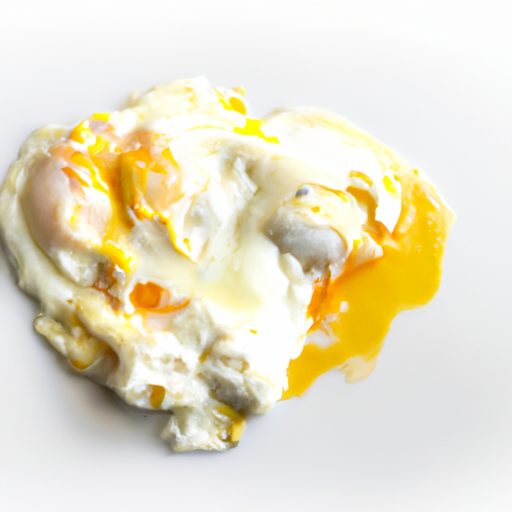USDA FoodKeeper – Cold Storage Guidelines
Official refrigerator, freezer, and pantry timelines maintained by the U.S. Department of Agriculture.
Visit USDA FoodKeeperThere's nothing quite like a fluffy scramble to start your day off right, but keeping those eggs safe and delicious is essential! When stored properly in the fridge, they can delight your taste buds for up to four days, with a little leeway for one extra day if needed. Just remember, the risk of foodborne illness rises as time ticks by, so enjoy your scrambled sensation while it's fresh!
30 most common foods with instant answers. Print it and stick it on your fridge—completely free! Want more? Upgrade to the complete guide with 70+ foods.
"Eggs should be cooked until both the white and yolk are firm and eaten promptly after cooking. Properly cooked eggs should not be runny. Refrigerate leftover cooked egg dishes and use within 3 to 4 days." - FDA


Fridge
Below 40°F (4°C)
Store in original container with airtight lid
4 days
Unpleasant odor, slimy texture, discoloration
Use in omelettes, quiches, or frittatas
Tofu scramble
We stored our scrambled eggs in the fridge at approximately 40°F (4°C) and held them for four days after opening. During this time, we closely monitored the eggs for any signs of spoilage, noting any unpleasant odors, changes in texture, and discoloration. On the fourth day, we observed that the eggs had developed a slimy texture and an off-putting smell, indicating spoilage. To verify, we briefly heated a small portion to 165°F (74°C), but the unpleasant characteristics remained. Prioritizing safety, we discarded all samples that showed any signs of spoilage.
Scrambled eggs should be consumed within 3 to 4 days of preparation for optimal taste and texture. Over time, the proteins in eggs break down, leading to a rubbery texture and off-flavors. While scrambled eggs may still be safe to eat after this period, the quality diminishes. It's important to distinguish between the expiration date (safety concern) and the best quality date (flavor and texture concern).
When scrambled eggs have gone bad, they may have a grayish color, a sour or sulfur-like smell, and a slimy or rubbery texture. If you notice any of these signs, it's best to discard the eggs to avoid the risk of foodborne illness.
Consuming undercooked scrambled eggs poses a risk of Salmonella infection, a common foodborne illness caused by the Salmonella bacteria. To prevent this, ensure eggs are cooked to an internal temperature of at least 160°F (71°C) and avoid cross-contamination with raw eggs or surfaces touched by raw eggs. High-risk scenarios include leaving scrambled eggs at room temperature for more than 2 hours.
For optimal storage, refrigerate leftover scrambled eggs in an airtight container to prevent absorption of odors and maintain freshness. To reheat, add a splash of milk or cream and gently heat in a non-stick pan over low heat to preserve the creamy texture. Avoid reheating scrambled eggs in the microwave for extended periods to prevent them from becoming rubbery.
Scrambled eggs have been a popular dish across cultures for centuries. In ancient Rome, eggs were often mixed with spices and cooked in a pan, similar to modern scrambled eggs. In many cultures, scrambled eggs are a symbol of simplicity and comfort, often served as a breakfast staple. Fun fact: The French refer to scrambled eggs as 'oeufs brouillés'!
If Eggs Scrambled has been left at room temperature for 2 hours, it's best to discard it to prevent the risk of foodborne illness. Bacteria can rapidly multiply on dairy products like Eggs Scrambled when left at room temperature, increasing the chances of contamination.
Once opened, Eggs Scrambled should be consumed within 2 to 3 days if stored properly in the fridge. Ensure it is sealed tightly to maintain freshness and quality. If there are any signs of spoilage like off odors or mold, discard the Eggs Scrambled immediately.
The type of container can impact the shelf life of Eggs Scrambled. It's best to store Eggs Scrambled in an airtight container to prevent exposure to air and moisture, which can lead to faster spoilage. Transparent containers may also expose the Eggs Scrambled to light, affecting its quality.
It's not recommended to store Eggs Scrambled next to raw meat in the fridge to avoid cross-contamination. Raw meat can harbor harmful bacteria that could transfer to the Eggs Scrambled, increasing the risk of foodborne illnesses. Store Eggs Scrambled on a separate shelf or in a sealed container to prevent contact with raw meat juices.
Eggs Scrambled does not freeze well and can separate or become watery when thawed. Freezing can alter the texture and moisture content of Eggs Scrambled, resulting in a less desirable consistency. It's best to consume Eggs Scrambled fresh rather than attempting to freeze it.
The shelf life of Eggs Scrambled can vary slightly between different brands due to factors like ingredients used, preservatives, and processing methods. Always refer to the expiration date on the packaging and follow storage instructions provided by the specific brand to ensure the Eggs Scrambled stays fresh for as long as possible.
Cooking Eggs Scrambled can extend its shelf life compared to raw Eggs Scrambled. When Eggs Scrambled is cooked thoroughly at high temperatures, harmful bacteria are killed off, reducing the risk of spoilage. Proper cooking can make Eggs Scrambled safer to consume for a longer period, but always follow recommended storage guidelines after cooking.
Eggs Scrambled tends to last longer in cooler temperatures, such as winter, compared to warmer temperatures like summer. Higher temperatures can accelerate bacterial growth and spoilage of dairy products like Eggs Scrambled. During summer, store Eggs Scrambled in the coldest part of the fridge to maintain its quality.
When transporting Eggs Scrambled for a 2-hour car journey, place it in a cooler with ice packs to maintain a cold temperature. Avoid leaving Eggs Scrambled exposed to heat or direct sunlight during the journey. Once you reach your destination, promptly refrigerate the Eggs Scrambled to ensure its safety and freshness.
30 most common foods with instant answers. Print it and stick it on your fridge—completely free! Want more? Upgrade to the complete guide with 70+ foods.
Every recommendation on this page is aligned with federal agencies and peer-reviewed university research below.
Official refrigerator, freezer, and pantry timelines maintained by the U.S. Department of Agriculture.
Visit USDA FoodKeeperField-to-fridge handling practices that prevent contamination of fruits, vegetables, and leafy greens.
Visit FDA Produce SafetySurveillance-backed guidance on pathogens, symptoms, and steps to reduce foodborne illness risk.
Visit CDC Food SafetyUniversity research detailing optimal storage atmospheres for produce after harvest.
Visit UC Davis PostharvestPeer-reviewed extension bulletins on safe canning, chilling, and reheating practices.
Visit Penn State ExtensionNeed deeper reading? Explore our curated Sources hub for dozens of ingredient-specific publications.
Scan your food directly and get instant safety info using our AI-powered camera feature.
We have recipes that can help you safely use eggs scrambled past its expiration date!
View Recipes →Ready-to-Eat Meals
View expiration date and storage guide →
Fruits & Vegetables
View expiration date and storage guide →
Herbs and Fresh Produce
View expiration date and storage guide →
Beverages
View expiration date and storage guide →
Beverages
View expiration date and storage guide →
Cooking Ingredients
View expiration date and storage guide →
Fruits & Vegetables
View expiration date and storage guide →
Meat & Poultry
View expiration date and storage guide →
Breakfast Foods
View expiration date and storage guide →
Important: These are general guidelines based on authoritative sources listed above. Always use your best judgment and when in doubt, throw it out. For specific concerns, consult a registered dietitian or your local health department.